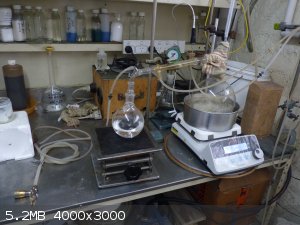FrankMartin
Hazard to Self
 
Posts: 50
Registered: 30-5-2010
Member Is Offline
Mood: No Mood
|
|
Vacuum Distillation
Hi, I'm vacuum distilling a 250degC Alkyl Malonic Ester in the apparatus pictured. When I set the oil-bath temperature and then adjust the vacuum I
get pronounced frothing and bubbling.
But if I set the vacuum and then let the temperature increase slowly the distillation proceeds at the desired 140degC.
Why this difference?
I attach an image of the vacuum distillation setup. A small needle valve & hose clamp maintains a vacuum of <10mm (vacuum oil-pump.) The
heating has a magnetic stirrer (750rpm). Regards F.

|
|
|
Sulaiman
International Hazard
    
Posts: 3558
Registered: 8-2-2015
Location: 3rd rock from the sun
Member Is Offline
|
|
When vacuum is applied before heating to 140 C
then boiling will begin at 140 C
at a rate determined by heating power input to the liquid.
If vacuum is not applied then the heating power will heat the liquid up towards 250 C
If vacuum is applied after the liquid temperature has exceeded 140 C then
relative to b.p. under vacuum, the liquid is superheated
so at the moment of applying vaccum the liquid will flash boil
the ammount of flash boiling determined by the excess heat energy above 140 C stored in the kiquid
I think 
CAUTION : Hobby Chemist, not Professional or even Amateur
|
|
|
NEMO-Chemistry
International Hazard
    
Posts: 1559
Registered: 29-5-2016
Location: UK
Member Is Offline
Mood: No Mood
|
|
Quote: Originally posted by FrankMartin  | Hi, I'm vacuum distilling a 250degC Alkyl Malonic Ester in the apparatus pictured. When I set the oil-bath temperature and then adjust the vacuum I
get pronounced frothing and bubbling.
But if I set the vacuum and then let the temperature increase slowly the distillation proceeds at the desired 140degC.
Why this difference?
I attach an image of the vacuum distillation setup. A small needle valve & hose clamp maintains a vacuum of <10mm (vacuum oil-pump.) The
heating has a magnetic stirrer (750rpm). Regards F.
|
In effect if you have something hot, the vac drops the pressure very quickly, which is alot like heating the liquid at extreme speed!
However if you set the vac first, then things have time to settle before the correct boiling point is reached.
Think of it as the difference between heating the flask with bunsen (vac is set first), and heating the flask by tossing it in a nuclear reactor going
full chat (high heat and sudden pressure drop).
Or
You meet a nice girl, you take her for a meal and get to know her, you take your time and in the end........job done
TO
Meet the girl in bar, pour bottle Vodka down her neck, 10 mins later try and complete the experiment in the bar........ Fireworks.
Speed and pressure in short 
Sul beat me to it!!
[Edited on 20-1-2018 by NEMO-Chemistry]
|
|
|
Magpie
lab constructor
    
Posts: 5939
Registered: 1-11-2003
Location: USA
Member Is Offline
Mood: Chemistry: the subtle science.
|
|
If you apply a vacuum to a hot liquid it becomes superheated very quickly. It will then boil rapidly giving you all that froth.
Edit: Sorry, Sulaiman I didn’t read your post slowly enough.
[Edited on 21-1-2018 by Magpie]
[Edited on 21-1-2018 by Magpie]
The single most important condition for a successful synthesis is good mixing - Nicodem
|
|
|
Reboot
Hazard to Others
  
Posts: 141
Registered: 8-8-2017
Member Is Offline
Mood: No Mood
|
|
Every liquid has a vapor pressure (the tendency to evaporate), which changes with temperature. For instance, if you heat up water, the vapor
pressure will slowly increase until the water reaches about 100 C. At that temperature, the vapor pressure can be higher than the atmospheric
pressure pushing down on the liquid.
And so it boils. The vapor is pushing itself out of the liquid phase with enough force to open up bubbles in the liquid.
On the other hand, if I heat the water up to, say, 95 C, then connect a high vacuum to it (such as the 10 mm you mention) the vapor pressure will be
much higher than the remaining air pressure in the flask, so it will boil at 95 C, and keep boiling until the water cools off enough to reduce it's
vapor pressure to less than 10 mm. (Which is, hmm, maybe somewhere around 20-25 C.)
So, when you heated it up first, it had to keep boiling (violently, I imagine) until it cooled down enough for it's vapor pressure to once again be
roughly balanced out by the pressure inside the flask.
|
|
|
aga
Forum Drunkard
    
Posts: 7030
Registered: 25-3-2014
Member Is Offline
|
|
Apart from the pressure and temperature there is the 'bumpiness' of a substance.
The worst i ever distilled was phenol.
It would boil nicely, then go as still as a pond before exploding up the column.
Generally i use a stirbar to mitigate 'bumping' these days.
In the end i had to destroy the phenol due it's pervasive and unpleasant smell.
Note: do not make and Store chemicals you have no immediate use for - some smell bad.
|
|
|
Magpie
lab constructor
    
Posts: 5939
Registered: 1-11-2003
Location: USA
Member Is Offline
Mood: Chemistry: the subtle science.
|
|
I love the smell of phenol and keep a small jar at my desk in case I need a whiff as a "pick-me-up."
Using an ebulliator is also a way to prevent bumping.
Bumping is often caused by solids on the flask bottom causing areas of superheat.
[Edited on 26-1-2018 by Magpie]
The single most important condition for a successful synthesis is good mixing - Nicodem
|
|
|